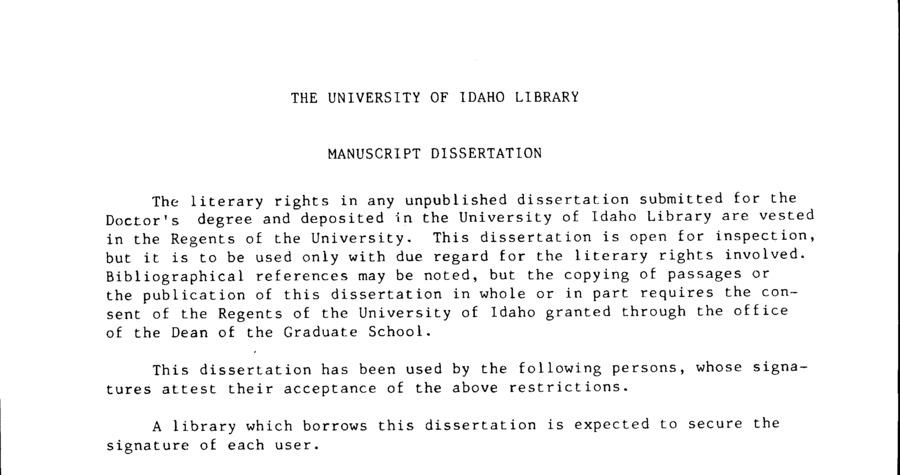PDF
Chemical speciation of arsenic and antimony in natural water systems and its applications to environmental problems Item Info
- Title:
- Chemical speciation of arsenic and antimony in natural water systems and its applications to environmental problems
- Authors:
- Mok, Wai Man
- Contributors:
- Idaho Water Resources Research Institute; IWRRI
- Date:
- 1988-05
- Description:
- A method for the speciation of trivalent and pentavalent states of inorganic arsenic (As) and antimony (Sb) in natural waters has been developed. The proposed method first extracts the trivalent As(III) and Sb(III) as pyrrolidinecarbodithioate (PCDT) complexes into chloroform, followed by a nitric acid back-extraction to recover the elements. Arsenic and Sb in the acid solution are determined by neutron activation analysis (NAA). The pentavalent species, As(V) and Sb(V), are reduced to the trivalent state using potassium iodide and sodium thiosulfate and then are extracted with PCDT for NAA. The two-step preconcentration procedure provides a large enrichment factor, eliminates the interfering matrix species, and extends the useful working range of NAA for As and Sb. The extraction method has also been applied to the determination of low levels of As and Sb in biological samples by NAA. The speciation method has been used to evaluate the distribution of As(III) and As(V) and its relation to other water quality parameters in the groundwater system of a major lead-zinc mine in the Coeur d'Alene Mining District of northern Idaho. It is known that mine wastes containing pyrite (FeS2) are capable of producing acid waters under oxidizing conditions, and the redox status of groundwater is an important factor in determining the degree of acid water formation and subsequent leaching of metals from mine tailings and ore bodies in this mining area. The results obtained from this study show that the relative concentrations of the arsenic redox pair are correlated with the quality of the mine waters studied and the ratio of As(V)/As(III) has the potential to be a redox indicator for groundwater systems. The river sediments of the South Fork and the Main Stem of the Coeur d'Alene River are contaminated with As, Sb, and other heavy metals from past mining activities. The distribution of As and Sb species in the river waters has been studied. Trivalent As(III) is the predominant form of arsenic in the South Fork and the Main Stem, whereas the unpolluted North Fork generally has a higher concentration of As(V). The major Sb species in the three branches of the river is Sb(V). Mobilization of sediment As and Sb during sediHent-water interactions has been investigated using laboratory leaching experiments. The releases of As and Sb are related to the free iron oxides and free manganese oxides of the sediments. The effects of the contaminated sediments on the water quality, with respect to As and Sb, of the creeks surrounding the Blackbird area in east-central Idaho have also been investigated. The pentavalent As(V) and Sb(V) are the major species observed in the creek waters. The field observations are consistent with the leaching experiments performed in the laboratory. The contaminated sediments are non-point sources of pollution which should be considered for water quality management planning of the mining areas studied.
- Subjects:
- heavy metals mine wastes sediments speciation
- Location:
- Coeur d'Alene River
- Idaho County:
- Shoshone County
- Latitude:
- 47.51
- Longitude:
- -116.15
- Collection:
- Coeur d'Alene Basin
- Source:
- University of Idaho
- Publisher:
- University of Idaho
- Contributing Institution:
- University of Idaho
- Type:
- Text
- Format:
- application/pdf
- Cataloger:
- wbv
- Date Digitized:
- 2012
- Language:
- eng
Source
- Preferred Citation:
- "Chemical speciation of arsenic and antimony in natural water systems and its applications to environmental problems", Idaho Waters Digital Library, University of Idaho Library Digital Collections, https://www.lib.uidaho.edu/digital/iwdl/items/iwdl-cda_mok_1988.html
Rights
- Rights:
- In copyright, educational use permitted. Educational use includes non-commercial reproduction of text and images in materials for teaching and research purposes. For other contexts beyond fair use, including digital reproduction, please contact the University of Idaho Library Special Collections and Archives Department at libspec@uidaho.edu. The University of Idaho Library is not liable for any violations of the law by users.
- Standardized Rights:
- http://rightsstatements.org/vocab/InC-EDU/1.0/

